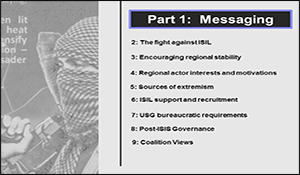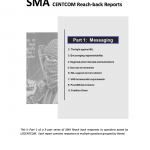Part 1 A Compendium of Messaging Reports

SMA CENTCOM Reach-back Reports – Part 1: Messaging.
Author | Editor: SMA Program Office.
This is Part 1 of a 9 part series of SMA Reach back responses to questions posed by USCENTCOM. Each report contains responses to multiple questions grouped by theme.
At the request of United States Central Command (USCENTCOM), the Joint Staff, Deputy Director for Global Operations (DDGO), jointly with other elements in the JS, Services, and U.S. Government (USG) Agencies, has established a SMA virtual reach-back cell. This initiative, based on the SMA global network of scholars and area experts, is providing USCENTCOM with population based and regional expertise in support of ongoing operations in the Iraq/Syria region.
The Strategic Multi-Layer Assessment (SMA) provides planning support to Commands with complex operational imperatives requiring multi-agency, multi-disciplinary solutions that are NOT within core Service/Agency competency. Solutions and participants are sought across USG and beyond. SMA is accepted and synchronized by Joint Staff (JS/J-3/DDGO) and executed by ASD(R&E)/EC&P/RRTO.
Responses were submitted to the following CENTCOM Questions:
- What are the predominant and secondary means by which both large (macro-globally outside the CJOA, such as European, North African and Arabian Peninsula) and more targeted (micro- such as ISIL-held Iraq) audiences receive ISIL propaganda?
- What are the USCENTCOM and the global counter-ISIL coalition missing from counter-messaging efforts in the information domain?
- What must the coalition do in the information environment to achieve its objectives in Iraq and Syria and how can it deny adversaries the ability to achieve theirs? – Part 1
- What must the coalition do in the information environment to achieve its objectives in Iraq and Syria and how can it deny adversaries the ability to achieve theirs? – Part 2
- The response to QL5 noted that ISIL is moving to ZeroNet platform for peer-to-peer messaging, which is extremely robust to distributed denial-of-service (DDOS) attack/other counter measures. What effect could this have on Intel efforts?
- The wide-spread, public access to smartphones has been a game-changer for the distribution and production of propaganda. Is there more data available about the types of apps (e.g., WhatsApp, Facebook, Telegram, Viber) used on smartphones to distribute propaganda, and the methods through which this is accomplished?

Comments